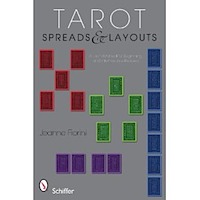By Sheri Harshberger
Jeanne Fiorini is an amazing writer and Tarot visionary who is now in her second decade as a Tarot practitioner and teacher. We are fortunate to count her among our regular contributors to Tarot Reflections, and are thrilled that she could take time out of her busy schedule to chat with us!
Tarot Reflections: Would you like to tell us a little about yourself?
Jeanne Fiorini: The first thing I might say is that I never dreamed that Tarot would be my career path. I chose it, yet it still surprises me. In some ways it’s been very challenging; on the other hand and at the same time it’s absolutely fabulous and I can’t imagine anything more interesting, stimulating, or important to be doing. I’ve always been interested in unexplained events, old objects, ancient civilizations, and anything of a transcendent nature: music, a really good book, a sincere and honest conversation.
TR: You have two successful books under your belt. When you wrote your first book, did you envision more books?
JF: When Invitation to Wonder was published in 2002, a Portland-area psychic said there would be three books by the time I was done. I didn’t have any ideas or motivations for a second book when the opportunity came to write the Tarot Spreads and Layouts book, but I was looking for new ways to “put Tarot out there.”
I’d contacted Schiffer Publishing after being at the Reader’s Studio in New York in 2009 where the publisher had had an informational booth, inquiring as to their interest in taking Invitation to Wonder into a new printing. Although they passed on that proposition, they had been looking for an updated version of a spreads and layouts book to add to their expanding section of metaphysical titles. In a moment of synchronicity, an editor at Schiffer visited my website and saw that I was offering a class entitled Tarot Spreads and Layouts: Simple and Effective Ways to Use Your Tarot Cards. Schiffer liked the title of the class as a book title, and in truth that single concept – that spreads could be simple as well as effective--was the guiding principle as Tarot Spreads and Layouts was written. Within a month we had signed contracts and the writing began!
TR: You've done some amazing things! In addition to your books, you have amazing Tarot-themed gift wrap papers and deck bags. Would you consider making a deck?
JF: No, and there are several reasons why. There are so many decks available these days and I don’t think I have anything new to add to the mix. Secondly, a good deck is years in the making, and I don’t have that kind of commitment to the project. I’ll leave it to someone with a new vision and some really great art and design ideas to give us something new on that score.
TR: Let's talk about your latest book, Tarot Spreads & Layouts. Why did you write it?
JF: Aside from the synchronistic way the book offer came to me, when I began researching the idea I saw that there was not a spreads and layouts book out there as I would have written it—this was encouraging! Sometimes people tell me I should write an introductory Tarot book, and I say “It’s already been done, and done very well. I don’t see the point.”
Additionally, once I began to construct an outline for the new book, it was soon apparent that there was a boatload of things I had to say about what to do before you even get to the “spreads and layouts” part of working with the Tarot. I became conscious of how important it is to talk about intuition, intention, an awareness of one’s world-view, and the reasons for being at the Tarot table in the first place. These are subtle aspects of reading Tarot that are rarely discussed in depth, but are essential components of developing a relationship with the cards. It’s only once we’re mindful about these sorts of things are we “cleared for take-off” with the cards.
TR: Speaking as a software developer by trade, I know that making things "user-friendly" puts a great burden on the developer... I believe the same goes for writers and books. This book is very user-friendly, was it difficult to write?
JF: The user-friendly aspect of the books wasn’t difficult because this is how I teach classes and also how I do readings. I like to explain to students and clients why I’m doing what I’m doing, why I’m saying what I’m saying, and from which cards on the table I’m getting my information. Tarot is such a wonderfully organized system of symbols that it’s a shame to overlook the connection between the actual symbol on the card and the verbal message from the card!
A symbol can communicate long after the words of a reading have dissipated; images stay in the mind in a way that words cannot. I can’t tell you how many times people have said things like, “That image stayed with me for years” or “The picture on that card really helped me stay calm” or “I never forgot the way I felt when I saw that Sun card.”
The only user-friendly aspect I would have liked to see happen with the new book was to have it spiral bound. There are physical-world reasons why this couldn’t happen during the publishing process, but if folks are inclined to take the book to the local office supply store they will bind it for you, making it much easier for it to lay flat while you’re working with spreads and layouts.
TR: While it is called Tarot Spreads & Layouts, you devote a significant number of pages to ethics and question creation, why?
JF: It is essential to know what we’re doing and why we’re doing it, whether it’s shopping for groceries, going on a date, or working with Tarot. In the book-signing events lately I’ve used this analogy involving a 78-piece pile of lumber: You wouldn’t dive in and start hammering various pieces of wood together willy-nilly and expect to get something useful from the process. In the same manner, we’ve got to have a clear motive/plan when we pull out our 78 Tarot cards: What are we building? For what purpose? What do we hope to gain from the process? What is the desired outcome? The templates, the spreads, and the layouts provide the “floor plan” for the construction of the story from the cards.
TR: Your approach with the templates is very freeing. How long did it take you to evolve your method of reading?
JF: I started reading and teaching Tarot professionally in 1991, and I’m still a work in progress. There’s always something to learn and integrate about Tarot, which is one of the things I appreciate about it. That factor is also something I enjoy about teaching, and it’s true that in each and every session a new insight into what is happening on/with/in the cards is brought to the surface.
Being someone with four planets in Libra, I always prefer a “both/and” solution rather than one that’s about “either/or.” (Please don’t make me choose just one!) For me, Tarot is about book learning and intuitive freedom. It’s about letting your conscious mind and your unconscious knowing have a voice during a reading. It’s about allowing linear thoughts and non-linear “hits” to have equal power in the Tarot session. The more we can structure the reading process around a few concrete principles, the more space there is for our intuition to reach in, expand, and explore.
With this in mind, I used patterns for the layouts in the new book which reflect the area of questioning. For example, the layout for questions regarding work and money matters is in the shape of a pentacle; the layout dealing with matters of closure is a square, reflecting the numerological associations with the Emperor/Death/Fool cards and the life/death/rebirth concepts held therein.
Finally worth noting is that much of the credit for my reading style goes to Mary Greer and her seminal Tarot for Your Self. Her description of the cards and the corresponding suggested questions for each at the end of that book were the groundwork for my experience with the Tarot. It suited my personality and style to hold a field of possibilities rather than stick to ONE absolute interpretation. Her book gave a context within which my thoughts and skills could grow; I hope that my Tarot Spreads and Layouts will provide such a structure for a new generation of Tarot workers.
TR: Is there anything you would do differently?
JF: There’s nothing different that I’d do about the book at this moment, but ask me in a year and I’ll probably have several points to mention! In regards to reading and teaching Tarot for a living, I’d try to have more faith in it as a viable trade and worry less about how it might all come together.
TR: What's next?
JF: I’m always interested in finding new ways to share what the Tarot has to offer. This coming June I’m doing a workshop in Boston with a Jungian analyst called Embodying the Archetypes of the Tarot, and I recently worked with a group of deep dreamers connecting the symbols of the Tarot with their most powerful dream images.
Over the next year or so I plan to make workshop visits to different parts of the country to share some of the simple yet effective ideas and concepts of the book. (If you’re interested in such a program for your area, feel free to contact me!)
On a more fanciful note, I’d love to be the collaborating Tarotist for a novelist. I adore the movie The Red Violin and would love to see someone write a Tarot-related novel with that kind of depth and interest.
Also -- I’ve integrated a new video feature into my website, the Tarot Tip of the Week. The videos can be seen at the TarotWorks website or by finding me on YouTube.
If you click “subscribe” on the YouTube page you’ll receive automatic notice when new installments are uploaded. The technology age— as it’s reflected in FaceBook, YouTube, Skype, LinkedIn -- is a wonderful boon for Tarot readers and teachers!
TR: Is there anything else you would like to share with our readers?
JF: Yes… use the book! Get it coffee-stained, bookmarked, and well-worn. Mark it up with your personal notes and observations and ideas for expanding the layouts. Share it with your friends and others who might benefit from the wisdom of the Tarot. We don’t need a lot of cards to get good information from the Tarot—a clear question and a simple layout will do the trick.

